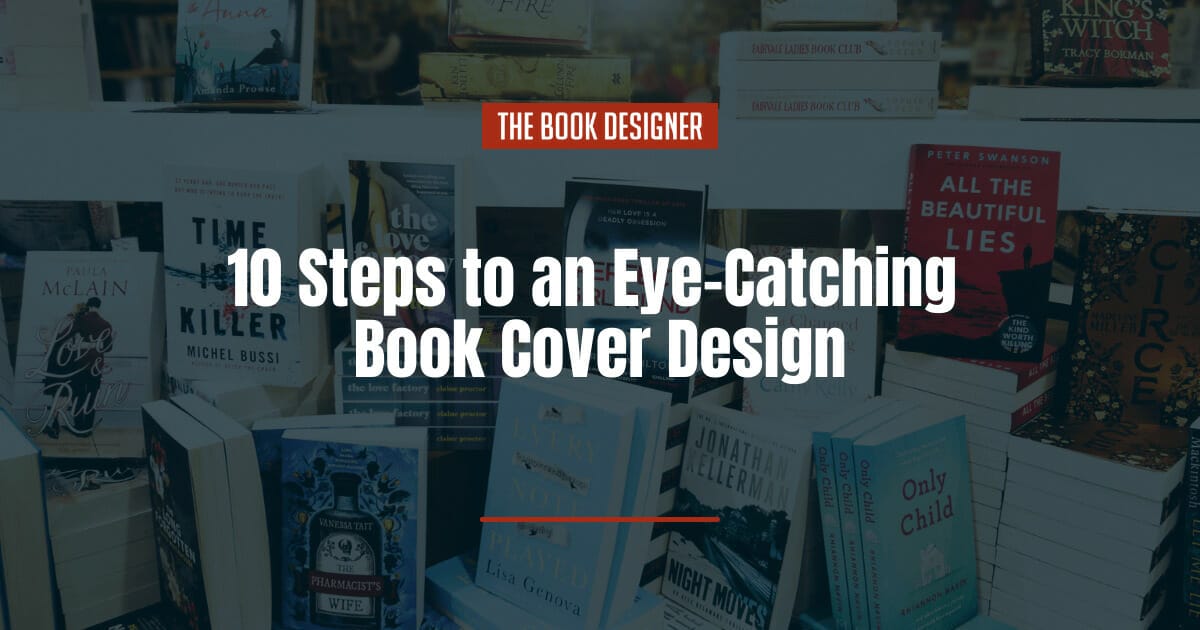Book cover design is where artistry meets strategy in self-publishing. Your book cover acts as a powerful ambassador, inviting readers into your narrative world. It’s not just about art—it’s about visual storytelling.
A well-crafted cover extends an invitation to readers through imagery, typography, and color, offering a glimpse into the world you’ve crafted. Moreover, a compelling book cover is a business asset, crucial for catching a potential buyer’s eye amidst a sea of options. In this guide, we’ll explore ten essential steps to create an eye-catching book cover that resonates with your target audience and propels your book towards success.
When tackling book cover design, you’ll want to have a firm grasp of:
Step 1: Understanding Your Book and Target Audience
Nailing your book’s genre and theme is fundamental to designing a great book cover. The genre sets the tone, signaling the type of story to potential readers—be it a thriller, romance, or sci-fi adventure. It’s the first brushstroke of your book cover design, providing a foundation.
Going deeper, the theme of your book encapsulates its emotional core and human experience. It’s what makes your narrative meaningful. When designing a book cover, incorporating the theme is like adding the right colors to a painting—it conveys the emotions and aspirations of your story.
Your book cover design needs to resonate with your target audience by aligning with their expectations for both genre and theme. Each genre has certain visual cues that readers anticipate. For example, fantasy readers expect mystical landscapes and awe-inspiring symbols. Ensuring your book cover design includes these elements while still showcasing your uniqueness is the key. In this step, explore how genre and theme alignment are crucial aspects of book cover design, ensuring it captivates the right audience and sets the stage for what’s inside.

Step 2: Researching and Analyzing Competing Book Covers
Before you dive into creating your own book cover design, thorough research is essential. Start by delving into the market and understanding the current trends in your book’s genre—particularly among the bestsellers. Knowing what’s popular and what works well within your genre will give you valuable insights into designing a cover that resonates with your target audience.
Part of this research involves analyzing successful book covers in your genre. Look for patterns and elements that consistently appear on covers of bestsellers or highly-rated books. Pay attention to color schemes, typography choices, and imagery. Understanding why these covers are effective can help you make informed decisions about your own design.
Additionally, assess the visual impact of these successful book covers. How do they draw the eye? What emotions do they evoke? Take notes on the elements that make these covers stand out. This analysis will serve as a valuable guide when you start crafting your own book cover design. By staying informed and studying what works in your genre, you’ll be better equipped to create a cover that captures the attention of potential readers.
Step 3: Identifying Key Design Elements
A book cover comprises several essential components that collectively contribute to its visual appeal and message. These elements include the title, author name, imagery, color scheme, font, and layout. Each of these components plays a critical role in shaping the overall impression of the book cover, attracting readers, and conveying the book’s essence.
Title and Author Name
The title and author name are prominent elements in a book cover design. The title is usually the largest text and should be easily readable from a distance. It’s the first thing that grabs attention and gives a glimpse of the book’s genre and tone.
The author’s name may be placed just below the title or at the top or bottom of the cover design (and sometimes is placed elsewhere entirely). Both elements sometimes share a specific font style and/or color to maintain visual consistency.
Imagery
The imagery on a book cover, whether it’s an illustration, photograph, or some combination, is a powerful tool for conveying the book’s genre and theme. Imagery creates a visual association for the reader, providing a sneak peek into the story’s world or the emotions it evokes. An intriguing image can captivate the reader, spark curiosity, and set the right mood, making them more likely to pick up the book.
The imagery needs to be relevant and compelling to the story, aligning with the genre and enticing the intended audience. It should also complement the other design elements, balancing the visual impact of the entire cover.
In non-fiction, your book cover’s imagery should still convey the theme and tone of your book. It should give readers insight into the knowledge contained within and how it will benefit them.

Color Palette
The color palette of a book cover is akin to its emotional palette. Colors evoke specific emotions and associations, making them a critical aspect of book cover design. For instance, warm tones like reds and oranges can convey excitement, passion, or danger, often fitting for genres like romance, thriller, or entrepreneurship.
On the other hand, cool tones like blues and greens evoke a sense of calm, making them suitable for genres like mystery, fantasy, or self-help. The right color scheme not only aligns with the book’s content and genre but also grabs attention amidst a myriad of other book covers, enhancing its visual appeal and memorability.

Typography
Typography, encompassing the font style, size, and arrangement of text, is more than just words; it’s a visual representation of the book’s personality. The font style should resonate with the book’s genre—a horror novel might use a jagged, unsettling font, while a romance novel might opt for a more elegant and flowing style.
The size and arrangement of the text should guide the reader’s eye, ensuring the title is prominent and easy to read, followed by the author’s name and any additional text. Well-chosen typography not only complements the imagery but also maintains harmony within the overall design, enhancing the book cover’s readability and conveying the book’s tone at a glance.
Step 4: Creating a Rough Sketch or Design Brief
A critical step in the book cover design process is translating your ideas and understanding into a tangible vision. This often begins with either crafting a design brief or sketching a rough draft.
A design brief is a written document that outlines your book’s essence, intended audience, visual preferences, and specific design elements you envision. It serves as a roadmap for you or your designer, ensuring that the design aligns with your expectations and goals. A well-crafted design brief sets the stage for the subsequent design process, providing a clear direction and minimizing misunderstandings.
Design Brief
When creating a design brief, clearly state your book’s genre, theme, and the emotions you want the cover to evoke. Define the core elements you wish to see, whether it’s particular imagery, color schemes, or font styles. Include any logistical details like dimensions and printing requirements.
A well-structured design brief acts as a foundation, helping you maintain focus and aiding designers in understanding your vision, ensuring that the resulting book cover design aligns with your objectives. Even if you plan to design your own book cover, creating a structured design brief can help you make sure that you’re incorporating all of the necessary elements based on your research.
Rough Book Cover Sketch
For those inclined towards a hands-on approach, starting with a rough sketch can be immensely beneficial. A rough book cover sketch is like a preliminary blueprint, giving you a visual representation of your design ideas.
A rough sketch of your book cover design doesn’t need to be detailed; the purpose is to organize your thoughts and experiment with layout, placement of elements, and overall composition. A sketch can act as a springboard, helping you refine your design direction before diving into the digital design process.
Incorporating Genre and Theme
While creating the initial design plan, always keep your book’s genre and theme at the forefront. Ask yourself how each element you incorporate aligns with the essence of your story. For instance, if your book is a mystery thriller, the design should instill a sense of intrigue and suspense.
Utilize color schemes and imagery that encapsulate the mood of your story. By infusing your design plan with elements relevant to your genre and theme, you set a strong foundation for the visual representation of your book, ensuring it resonates with the right audience.

Step 5: Choosing the Right Design Tools and Software
Selecting the appropriate design tools and software is a pivotal step in crafting an eye-catching book cover, especially for those venturing into design without professional expertise. Among the array of design platforms available, Canva stands out as an excellent tool, particularly for amateur designers. It includes an intuitive and user-friendly interface, equipped with an array of pre-designed templates, fonts, imagery, and customization options.
Canva allows aspiring designers to experiment, create, and customize book covers effortlessly, even if they don’t possess advanced design skills. This is also an excellent option if you want to create some mockups to show a designer who will be creating the final cover design.
Step 6: Designing the Initial Draft for Your Book Cover Design
Once armed with a clear design brief or a rough sketch, it’s time to breathe life into your book cover concept by transitioning it into an initial draft design. This phase involves transferring your outlined ideas into a digital format, where you can manipulate and refine the design elements.
Begin by selecting the appropriate software, keeping in mind your comfort and proficiency levels. Start placing the crucial elements like title, author name, imagery, and any other specifics onto the canvas. Experiment with different layouts, fonts, colors, and imagery to see how they interact and contribute to the overall visual appeal. The goal at this stage is to create a rough representation of what you envisage for your book cover.
Importance of Experimentation and Iteration
The process of translating your design brief or sketch into the initial draft is as much about experimentation as it is about implementation. It’s a time to explore various possibilities and iterate through different design choices.
Experiment with different fonts to see which one complements your book’s genre and theme. Test various color schemes to find the one that conveys the right mood.
Experimentation allows you to gauge what works and what doesn’t, enabling you to make informed design decisions. Moreover, iteration is key in refining your design. It’s rare to get the perfect design on the first try, and this phase allows you to tweak and enhance elements, ensuring the final book cover design is polished and visually compelling.
Through thoughtful experimentation and iteration, you’ll evolve your initial draft into a captivating book cover that aligns perfectly with your vision.
Step 7: Seeking Feedback and Iterating Some More
In the journey of book cover design, feedback from trusted sources is akin to a compass, guiding you in the right direction. Once you have your initial draft design, share it with a small circle of individuals whose opinions you value—fellow authors, designers, or potential readers in your target audience. Encourage honest feedback, emphasizing that you seek constructive criticism.
Pay keen attention to their reactions, suggestions, and concerns. Do they find the imagery compelling? Is the title easily readable? Is the design aligned with the book’s genre and theme? These insights will shed light on elements that may need tweaking or enhancement. Remember, the goal is not just to design a cover you like, but one that resonates with your potential readers.
How to Use Feedback for Iteration
The feedback obtained during this phase is a crucial blueprint for iteration. Analyze the feedback carefully, considering each suggestion in the context of your book and its intended audience. Identify recurring feedback and prioritize the changes accordingly. Perhaps it’s adjusting the color scheme to evoke the desired emotions more effectively or refining the font for better readability.
The iterative process involves making these modifications, fine-tuning the design, and creating updated drafts. Through this iterative loop, you gradually refine your book cover design, integrating diverse perspectives until you achieve a version that truly encapsulates the essence of your book and resonates with your audience.
Remember, too, that you don’t have to take every suggestion given to you. But if multiple people bring up the same issue, it’s definitely worth exploring how to fix it.
Step 8: Finalizing the Book Cover Design
As you approach the final stages of creating your book cover design, attention to detail becomes paramount. Begin by making the necessary adjustments based on the feedback received during the iteration phase.
Ensure the title and author name are prominently positioned and clearly visible at various scales. Double-check the alignment and spacing of all elements to achieve visual balance. Assess the color contrast and readability to guarantee that the text is legible against the chosen background. Simplicity and clarity are key here; a cluttered or confusing design can deter potential readers.
Additionally, verify that the imagery used aligns seamlessly with your book’s genre and theme, contributing to a cohesive and engaging visual narrative.

Ensuring Your Book Cover Design Meets Printing and Digital Standards
Before finalization, it’s crucial to ensure that your book cover design adheres to the printing and digital standards of the platforms you intend to use. Check the resolution of images, ensuring they meet printing quality requirements (typically 300 DPI, with full bleeds to hide printing errors). Confirm that the design fits the specified dimensions for print and digital formats.
RGB color mode is standard for digital (like ebook covers), while CMYK is typically used for printing, so make this adjustment accordingly. Additionally, consult the guidelines provided by your chosen publishing platform to meet their specific requirements. Ensuring your design meets these technical standards guarantees a seamless transition from digital mockup to the printed book cover, ensuring a professional and polished final product.
If you ever have questions about the file specifications you need to use, consult your book printing company or ebook distributor. Most have thorough specifications available, either directly on their website or by request.
Step 9: Testing Your Book Cover Design
Before the grand reveal of your book cover, it’s crucial to conduct thorough testing to ensure it will resonate with your target audience. One effective way to do this is by creating focus groups or sharing the design on various social media platforms or online book communities.
Encourage honest feedback from these potential readers, gauging their initial reactions and perceptions. Additionally, consider conducting A/B testing by presenting variations of the book cover to different groups and analyzing which version garners more positive responses.
The insights gained from these tests are invaluable, providing a final opportunity to refine your design before its official release. Remember, testing isn’t about seeking unanimous approval but understanding your potential readers’ preferences and making informed decisions to enhance your book cover’s effectiveness.
If necessary, there’s still time to make any tweaks to your design at this stage. It gets much more difficult once your book is published.
Step 10: Publishing and Promoting Your Book Cover Design
The final step is to seamlessly integrate your book cover design into the publishing and promotional phase to maximize book sales. Utilize your eye-catching book cover as a central element in all promotional materials.
Start with your book’s listing on various online platforms—ensure the cover is displayed prominently, accompanied by a compelling book description. Leverage the power of social media by featuring your book cover in posts, teasers, and advertisements. Visual platforms like Instagram and Pinterest can be particularly effective for showcasing your book cover’s aesthetics.
Consider creating promotional materials such as banners, bookmarks, or postcards featuring your book cover. These tangible elements can be distributed at book fairs, author events, or local bookstores to grab the attention of potential readers.
Furthermore, design digital ads for online promotion, employing the book cover as the central visual. Through consistent and strategic use of your book cover in promotional materials, you not only increase its visibility but also establish a visual brand for your book, making it instantly recognizable to your target audience. The goal is to make your book cover a symbol that represents your literary creation, enticing readers to explore the narrative within.

Crafting an Inviting Book Cover—Your Gateway to Readers
In these ten essential steps, we’ve navigated the basics of book cover design, a crucial aspect of your book’s success. Understanding your genre and theme, researching successful book covers, and identifying key design elements set the foundations. These elements, comprising title, author name, imagery, color scheme, and typography, collectively shape the visual tapestry of your book cover, capturing attention and conveying your book’s essence.
Translating your vision into a tangible draft, seeking valuable feedback, and iterating based on insights helps fine-tune your design to perfection. Testing the final design among your target audience ensures it resonates effectively, offering the opportunity for further adjustments. Finally, integrating your book cover seamlessly into your publishing journey and promotional materials is the key to unlocking the door to a vast readership.
Whether you’re a design enthusiast or brand new to the world of book cover design, remember, investing time and effort into creating a captivating book cover is an investment in your book’s success.
If design doesn’t fall within your realm of expertise, fear not—consider enlisting the assistance of a professional designer. But understanding the basics of what’s important in a book cover design will allow you to work more effectively with whichever designer you end up working with.
Your book cover is your literary storefront, an invitation to readers to explore the worlds you’ve crafted. Let it be a reflection of the beauty and intrigue your words hold within, for a well-designed cover is the gateway that leads readers to the literary treasures that await them.




